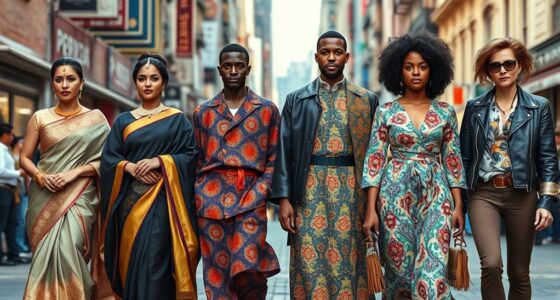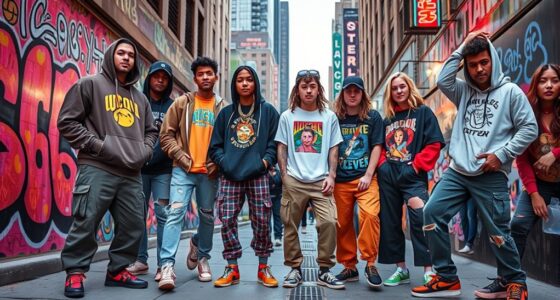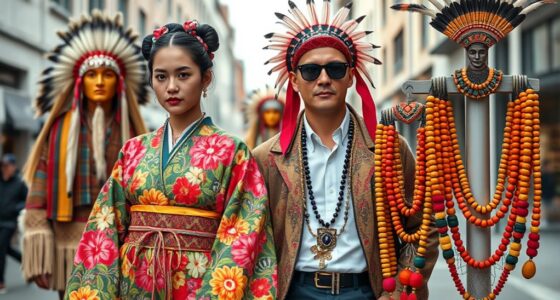Fashion icons through the decades shape culture by setting trends, challenging norms, and expressing societal values. Hollywood stars of the Golden Age inspired timeless elegance, while the rebellious 1960s broke traditional rules with bold styles. The power dressing of the 1980s reflected societal shifts in confidence and gender roles. Youth movements like grunge and streetwear redefined rebellion and individuality. Today’s influencers continue to reshape fashion and culture, making it essential to explore their ongoing influence.
Key Takeaways
- Hollywood icons like Audrey Hepburn and Marilyn Monroe set enduring standards of elegance, influencing societal perceptions of beauty and femininity.
- 1960s fashion rebellion with bright colors and geometric patterns reflected social upheaval and youth activism.
- 1980s power dressing with shoulder pads and bold silhouettes symbolized female empowerment and authority.
- 1990s streetwear and grunge styles challenged traditional beauty norms, emphasizing individuality and anti-establishment attitudes.
- Contemporary icons and influencers utilize fashion for activism, promoting inclusivity, diversity, and social justice movements.
The Golden Age of Hollywood and the Rise of Style Icons
Have you ever wondered how Hollywood stars of the Golden Age defined timeless style? Back then, these icons set standards that still influence fashion today. Think of Audrey Hepburn’s elegant simplicity or Marilyn Monroe’s sultry glamour. They knew how to command attention with carefully chosen outfits, perfect silhouettes, and iconic accessories. Their style was polished, sophisticated, and accessible, making everyday people aspire to emulate their looks. Hollywood studios carefully crafted their images, turning actors into symbols of glamour. This era’s fashion emphasized femininity, elegance, and confidence—traits that continue to shape beauty ideals. These stars weren’t just entertainers; they became trends, inspiring designers and fans alike. Their influence proved that style can be a powerful form of self-expression and cultural identity, especially as automation technologies began to influence a wide range of industries during that period. The enduring appeal of their image also underscores how cultural symbolism in fashion can transcend time and trends.
The Swinging Sixties: Fashion as a Form of Rebellion

During the 1960s, fashion became a bold statement of rebellion against traditional norms, reflecting the era’s social upheaval and desire for change. You’d see young people challenging conventions with bright colors, geometric patterns, and mini skirts, breaking away from conservative styles. Mod fashion and psychedelic prints expressed individuality and a desire for freedom. The youth embraced bold accessories, such as large earrings and beaded necklaces, to stand out. Hairstyles like the bouffant and beehive symbolized rebellion against previous standards of femininity. Fashion became a way to protest, express identity, and push boundaries. You’d notice how designers and trendsetters used clothing to reflect the spirit of activism and cultural shifts, making fashion a powerful tool for social expression during this transformative decade. Additionally, the use of colorful fabrics and innovative patterns further emphasized the desire to challenge traditional aesthetics and norms. The influence of Youth Culture on fashion trends underscored its role as a form of social commentary and personal identity. Furthermore, the adoption of innovative textiles and experimental designs showcased how fashion was evolving as a form of artistic expression and social rebellion, highlighting the importance of Cultural Intelligence in understanding these shifts. Moreover, the increasing popularity of sustainable fashion practices during this period hinted at a future focus on environmental consciousness in style.
The Glamour of the 1980s and the Power Dressing Movement
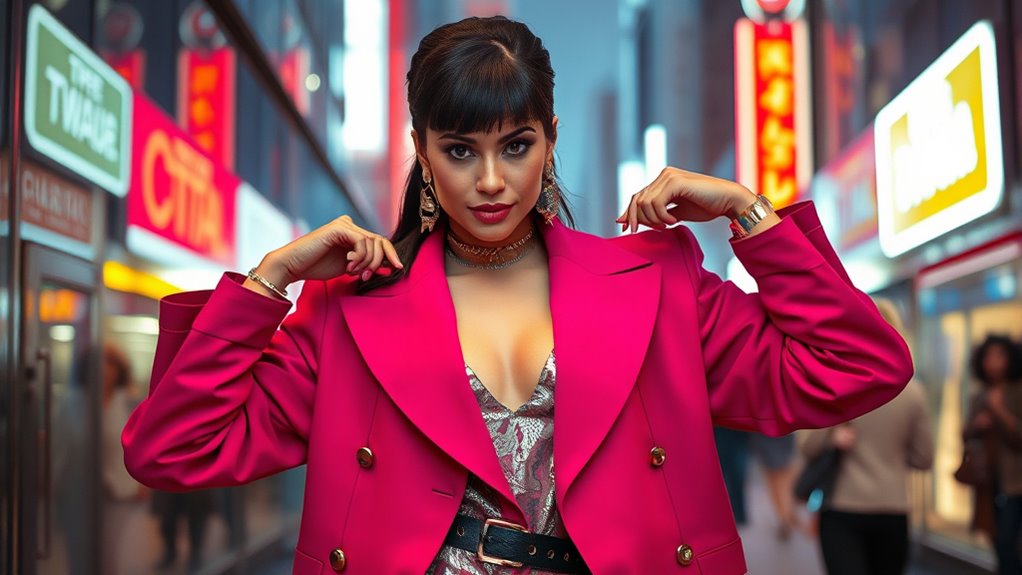
The 1980s brought a bold new look with shoulder pads that made a strong statement. Power suits evolved into symbols of confidence and authority, shaping how women presented themselves. These fashion choices defined an era where strength and glamour went hand in hand. Additionally, the era saw a rise in investment diversification strategies, encouraging women to embrace a multifaceted approach to personal and financial empowerment. This shift in fashion trends reflected a broader cultural movement towards financial independence, empowering women to take control of their futures. Furthermore, innovative clothing materials contributed to the development of more structured and expressive styles that epitomized the decade’s bold aesthetic. The use of personalities like the alpha male and sanguine traits can be seen in the confident and lively demeanor of many fashion icons of the time.
Bold Shoulder Pads
Bold shoulder pads defined the 1980s fashion scene, transforming everyday outfits into powerful statements. You’d see them on blouses, blazers, and dresses, instantly adding structure and authority to your look. This trend symbolized confidence, emphasizing strength and professionalism in both work and social settings. Designers like Donna Karan and Thierry Mugler popularized exaggerated silhouettes, making shoulder pads a must-have for anyone wanting to stand out. They gave women a commanding presence, aligning fashion with the era’s focus on empowerment and boldness. The padded shoulders became a badge of the decade’s daring spirit, shifting perceptions of femininity and power dressing. If you wore them, you embraced a style that shouted confidence, making a statement that resonated far beyond the runway. Regularly, the mindfulness techniques of these fashion icons ensured they remained as striking as the day they debuted.
Power Suit Evolution
In the 1980s, power suits became symbols of ambition and authority, transforming everyday workwear into bold statements of confidence. You’d notice wide-shouldered jackets, strong lines, and tailored fits that emphasized strength and professionalism. Designers pushed boundaries with bright colors, oversized blazers, and padded shoulders, making the suit a symbol of empowerment. Women embraced power dressing, breaking traditional gender roles, and asserting authority in male-dominated spaces. The suit evolved from basic business attire to a fashion statement that conveyed power and independence. As a result, it became a cultural icon of the era, inspiring confidence and challenging societal norms. This transformation marked a pivotal moment in fashion history, blending style with activism and redefining the professional wardrobe forever. Understanding the evolution of fashion helps contextualize how clothing can serve as a form of social and political expression. Additionally, the rise of power dressing reflected broader cultural shifts toward gender equality and female empowerment during that period. Recognizing the business attire of the era provides insight into how fashion mirrored shifting workplace dynamics and societal expectations. Moreover, the impact of design innovation during this era contributed to the bold aesthetics associated with power dressing.
Grunge and Streetwear: Redefining Youth Culture in the 1990s
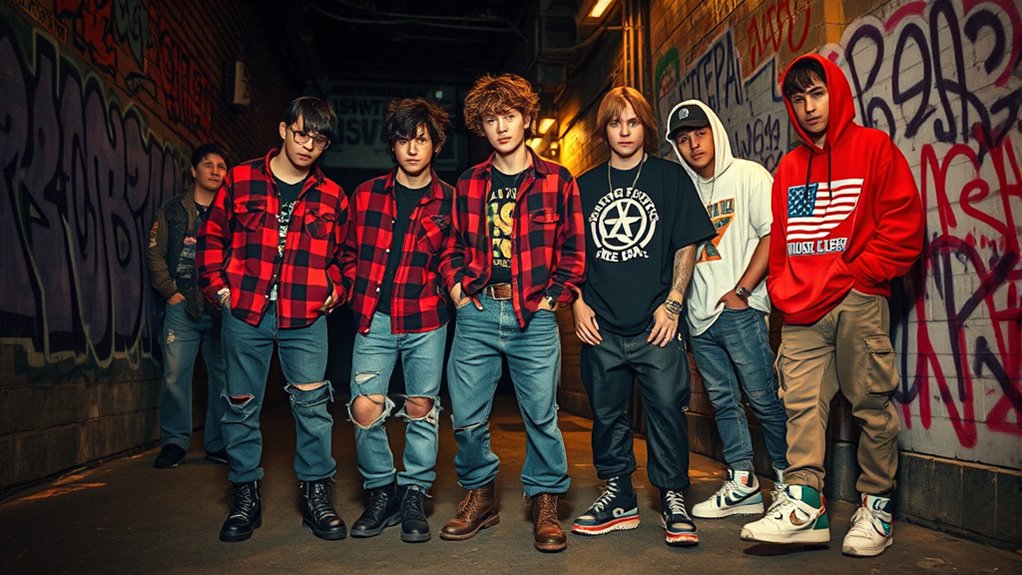
In the 1990s, grunge style emerged from Seattle’s music scene, blending thrifted clothing with a rebellious attitude. Streetwear brands like Stüssy and Supreme gained popularity, shaping a new urban aesthetic. Their cultural influence transformed youth identity and left a lasting legacy on fashion today. Additionally, the rise of anime movies during this era reflected a growing appreciation for diverse storytelling and visual artistry, influencing fashion trends and pop culture. Furthermore, the rise of AI in retail success during this era reflected a desire for individuality and self-expression among young people. As technology and fashion continued to intersect, the role of AI ethicist jobs became increasingly significant in shaping responsible innovation within the industry.
Origins of Grunge Style
Have you ever wondered how the gritty, rebellious style of grunge emerged from the Seattle underground to influence mainstream youth culture? It all started in the late 1980s when local bands like Nirvana and Pearl Jam rejected polished, glamorous trends. Instead, they embraced a look rooted in thrift store finds, flannel shirts, ripped jeans, and combat boots—clothing that reflected their disillusionment and anti-establishment attitude. This style wasn’t about fashion perfection but about comfort, authenticity, and a sense of belonging. The grunge aesthetic was a response to the economic struggles and social alienation felt by many young people at the time. As bands gained popularity, their style spread, transforming into a powerful cultural statement that challenged conventional beauty standards and reshaped youth identity. Additionally, the influence of streetwear prominently contributed to the evolution of this rebellious fashion movement, blending practicality with style.
Rise of Streetwear Brands
Did streetwear brands truly transform youth culture in the 1990s? Absolutely. You saw brands like FUBU, Cross Colours, and Stüssy emerge as symbols of rebellion and individuality. They prioritized comfort, affordability, and self-expression, making fashion accessible to a wider audience. This movement challenged the dominance of high-end fashion, shifting the focus toward urban aesthetics and skate-inspired styles. You noticed how collaborations with musicians and artists amplified their influence, turning streetwear into a cultural phenomenon. It wasn’t just about clothing; it was about identity, attitude, and community. As the 1990s progressed, streetwear became a powerful force, reshaping how young people expressed themselves and how brands connected with youth culture. Incorporating variety of materials and innovative designs, these brands continually evolved to meet the changing desires of their audience.
Cultural Influence and Legacy
The 1990s revolutionized youth culture through the powerful influence of grunge and streetwear, shaping how young people expressed their identities. You see, these styles broke traditional fashion rules, emphasizing comfort, individuality, and a rebellious attitude. Grunge’s flannel shirts, ripped jeans, and combat boots became symbols of discontent and authenticity, while streetwear’s bold logos and oversized fits challenged mainstream norms. This movement fostered a sense of community among youth, giving voice to their frustrations and aspirations. Its impact endures, influencing today’s fashion and pop culture. You now recognize that what started as a countercultural statement transformed into mainstream trends, shaping how generations see themselves and their place in society. The legacy of 1990s streetwear and grunge continues to influence fashion’s evolution.
The Digital Age and the New Wave of Influencers

How has the digital age transformed the landscape of fashion icons? You now have instant access to the latest trends and style inspiration through social media platforms like Instagram, TikTok, and YouTube. Influencers emerge overnight, building followings based on authenticity and relatability rather than traditional celebrity status. You can see behind-the-scenes glimpses of fashion weeks, collaborations, and personal style journeys in real-time. This shift democratizes fashion, allowing everyday people to become trendsetters and shaping what’s considered fashionable. Brands now prioritize digital presence, engaging directly with audiences and leveraging micro-influencers for targeted campaigns. The digital age accelerates the pace of change, making fashion more accessible and interactive. As a result, influencers influence not just trends but also cultural conversations around beauty, identity, and self-expression. Additionally, the emphasis on developmental milestones encourages a more inclusive and diverse representation of style and identity in the digital space. The rapid dissemination of fashion content also fosters a culture of constant innovation, where new styles and ideas emerge and evolve at an unprecedented speed.
Contemporary Icons Shaping Today’s Fashion and Society
Contemporary icons are redefining fashion and shaping societal values through their bold expressions of identity and activism. You see stars like Billie Eilish challenging traditional beauty standards with unique style choices, inspiring others to embrace authenticity. Fashion influencers like Zendaya mix high fashion with streetwear, breaking barriers and promoting inclusivity. Social media empowers these icons to directly connect with audiences, amplifying their messages. Their influence extends beyond clothing; they advocate for social justice, environmental issues, and mental health awareness. By doing so, they encourage society to rethink norms and prioritize diversity. Additionally, attention to their craft and messaging enhances their impact, inspiring others to pursue their creative passions with dedication. These icons don’t just set trends—they shape cultural conversations and inspire change. As a result, they motivate you and others to express yourself freely and stand for what matters.
Frequently Asked Questions
How Did Fashion Icons Influence Global Cultural Trends Beyond Clothing?
You see, fashion icons do more than just set clothing trends; they shape global culture. Their bold choices inspire music, art, and social movements, encouraging self-expression and challenging norms. By embracing innovation and individuality, they influence attitudes and values worldwide. You might find yourself adopting their styles or supporting causes they champion, showing how their impact extends beyond fashion into broader societal change and cultural identity.
What Role Did Technology Play in Shaping Modern Fashion Icons’ Influence?
Imagine a world before social media, where technology now acts as your virtual runway. It shapes how modern fashion icons influence culture by enabling instant sharing, global reach, and real-time feedback. You see their styles go viral, shaping trends faster than ever. Technology’s power transforms icons into digital influencers, making fashion more accessible and interconnected. You become part of this evolving scene, where innovation drives cultural shifts in style and identity.
How Do Fashion Icons Challenge or Reinforce Societal Stereotypes?
You see that fashion icons often challenge stereotypes by breaking traditional norms and embracing individuality, encouraging others to do the same. At times, they reinforce societal expectations through specific styles or branding that align with popular ideals. Their influence shapes perceptions, either pushing boundaries or maintaining status quo. By choosing their looks intentionally, they either defy or uphold stereotypes, impacting cultural attitudes about identity, beauty, and gender roles.
In What Ways Do Lesser-Known Icons Impact Fashion History and Culture?
You might think only famous icons influence fashion history, but lesser-known figures also make a big impact. They introduce fresh ideas, challenge mainstream trends, and inspire future designers. By doing so, they shape cultural diversity and innovation, often quietly, yet profoundly. Their unique styles can ignite new movements, proving that influence isn’t always about fame but about the power to inspire change and expand fashion’s creative boundaries.
How Has Social Media Changed the Accessibility of Becoming a Fashion Icon?
Social media has made becoming a fashion icon more accessible for you. Instead of waiting for mainstream recognition, you can showcase your style instantly to a global audience. Platforms like Instagram and TikTok allow you to build a personal brand, share trends, and influence others directly. This democratizes fashion, giving everyone a chance to inspire and be recognized, regardless of traditional industry gatekeepers.
Conclusion
You’ve seen how fashion icons have shaped culture through the decades, from Hollywood glitz to digital trends. Each era’s style sparks new waves of inspiration, proving that fashion is more than just clothes—it’s a way to make your mark. Remember, it’s not just about keeping up; it’s about standing out. So, don’t be afraid to break the mold and let your style speak volumes—because in fashion, you’re the one calling the shots.

